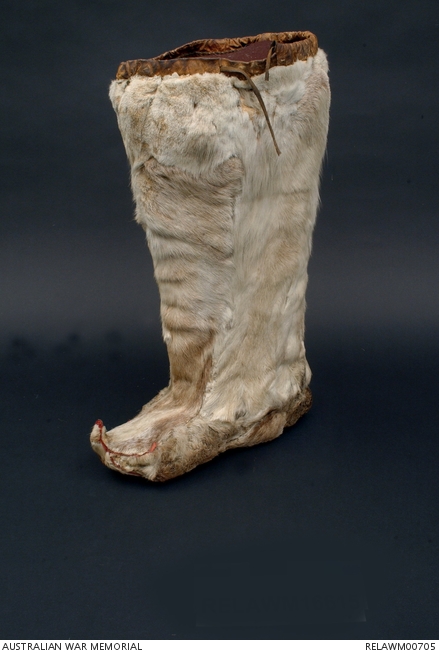| Place | Europe: France, Picardie, Somme, Corbie Albert Area, Corbie |
|---|---|
| Accession Number | RELAWM00705 |
| Collection type | Heraldry |
| Object type | Personal Equipment |
| Physical description | Fur, Leather |
| Maker |
Unknown |
| Date made | c 1914-1918 |
| Conflict |
First World War, 1914-1918 |
Left flying overboot : Baron M von Richthofen, Geschwader 1 German Air Service

Flier's knee high left overboot, custom-made from narrow sections of pelts, possibly deer, with the fur side being outermost. The pelts have been sewn together vertically with linen thread using the 'top sewing' method. A band of doubled-over leather containing a drawstring leather thong, which is tied at the outside of the wearer's leg, has been sewn around the top of the boot. Red wool trim is sewn around the toe.
This left flying overboot was salvaged from Baron Manfred von Richthofen's Fokker downed aircraft by Lieutenant Walter John Warneford, 3 Squadron Australian Flying Corps (AFC), after von Richthofen was shot down and killed near Corbie, France, on 21 April 1918.
In a letter written by Warneford, he recorded that he led a recovery party from the 3 Squadron AFC aerodrome to map reference [map scale 1:40,000] Sheet 62D, grid J19 b 44, where they were in full view of the enemy. The party recovered von Richthofen's body, the aircraft's control column (RELAWM00704) and this left flying over-boot. It is thought that von Richthofen originally acquired the pair of overboots from a British pilot he shot down. The right overboot was collected by Captain William Valentine Herbert, who was also serving with 3 Squadron AFC (RELAWM16615) at the time.
The other members of the party were 726 Sergeant Lewis Richard Foale, 1456 Air Mechanic 2nd Class Benjamin John Harper, 756 Air Mechanic 1st Class Sidney Guy Penistan, 606 Air Mechanic 1st Class Alfred Alexander Boxall-Chapman, 1434 Air Mechanic 2nd Class Leonard Chapple, 662 Air Mechanic 1st Class Colin Campbell Collins, 682 Air Mechanic 1st Class James William Robert Bryce Roland.
Warneford was born in Liverpool, England on 3 February 1883 and was a military instructor on enlistment in the 1st Light Horse Regiment on 26 September 1914. He had previously served for two years with the 7th Queen's Own Hussars during the Boer War before immigrating to Australia where he became a permanent staff officer.
He embarked for overseas service with the service number 41 and rank of staff sergeant major aboard HMAT Star of Victoria on 20 October, arriving in Egypt on 8 December. Proceeding to join the Mediterranean Expeditionary Force on 5 April 1915, Warneford landed with the 1st Division Headquarters at Gallipoli on 25 April. At some point his service number was changed to 136. He was promoted to the rank of warrant officer and transferred to General Birdwood's General Staff on 1 May.
Admitted to No 1 Stationary Hospital, Lemnos with chronic appendicitis on 28 July, Warneford was eventually transferred to hospital in Cairo on 9 August. Invalided back to Australia aboard HMT Euripides on 29 August, Warneford rejoined the AIF after a period of convalescence as a member of the 53rd Battalion, 7th Reinforcements on 20 May 1916.
Embarking as a second lieutenant aboard HMAT Ascanius on 26 October, Warneford disembarked at Devonport, England on 28 December. He was appointed signalling officer to No. 3 E Group on 12 January 1917 where he remained until August when he transferred to the 30th Training Squadron, AFC.
Proceeding overseas to France in March 1918 Warneford was taken on strength by 3 Squadron on 1 April. He sustained a fractured nose in an accident on 13 August when he was an observer in an RE8 aircraft piloted by Lieutenant Roderick Charles Armstrong. Armstrong was attempting to take off after a forced landing but before he could gain sufficient speed to leave the ground, the machine struck a shell hole. Warneford was thrown against the gun mounting, fractured his nose and was admitted to 20 Casualty Clearing Station.
Returning to his unit Warneford remained with 3 Squadron until the end of the war. He returned to Australia aboard HMAT Barambah embarked on 3 September 1919. He disembarked in Melbourne on 25 October with his appointment in the AIF terminated on 2 January 1920. Warneford died on 20 April 1951.
Share this page
Related information
Conflicts
Events
Related Objects
- Compass from Fokker Dr I : Baron Manfred von Richthofen, Geschwader 1, German Air Service
- Piece of fabric from Fokker DR1 aircraft : Baron Manfred von Richthofen, Geschwader 1, German Air Service
- Part of the propeller from Fokker Dr I : Baron Manfred von Richthofen, Geschwader 1, German Air Service
- Part of the propeller from Fokker Dr I : Baron Manfred von Richthofen, Geschwader 1, German Air Service
- Part of the propeller from Fokker Dr I : Baron Manfred von Richthofen, Geschwader 1, German Air Service
- Piece of fabric from Fokker aircraft : Baron Manfred von Richthofen, Geschwader 1, German Air Service
- Part of the propeller from Fokker Dr I : Baron Manfred von Richthofen, Geschwader 1, German Air Service
- Part of propeller from Fokker Dr I : Baron Manfred von Richthofen, Geschwader 1, German Air Service
- Aircraft night lozenge camouflage fabric
- Control column : Baron M von Richthofen, Geschwader 1, German Air Service